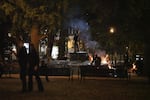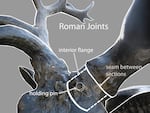
An artists' rendition of the Thompson Elk in downtown Portland, expected to be installed in 2023.
Courtesy of MIG, Inc.
Robert Krueger is a fine art conservator specializing in three-dimensional works – think ancient pottery, family heirlooms and statues.
After the Thompson elk was damaged during the political protests of 2020, the Portland Regional Arts and Culture Council brought Krueger in to see if the statue was fixable.
“It’s kind of an icon downtown,” Krueger said during a recent talk over his dining room table. “For years, every day, I’d go downtown and pass by the elk.”
The statue that used to stand at Southwest Main between 3rd and 4th Avenues was donated by Portland Mayor David Thompson in 1900 to commemorate the elk that once roamed the area, and to honor the Oregon Humane Society, which he co-founded. The bronze artwork depicts a bull elk with impressive antlers, and for 120 years, it has glanced up into Portland’s West Hills as if checking for danger.
The statue was installed with a fountain at its base, and for a long time was the first spot visitors coming to Portland from the west could stop to get a drink of water.
But now, the elk is surrounded by Portland City Hall, the federal building, the Multnomah County courthouse and the Portland Police Bureau’s Central Precinct. Over the years, along with all that growth, the elk has witnessed two world wars, two pandemics and an estimated 33 major political protests, from marches for women’s suffrage in the early 20th Century to the months of protests for racial justice in 2020.

A protester stands where an elk statue used to stand during protests against racism and police violence on July 14, 2020.
Jonathan Levinson / OPB
City crews removed the elk in July 2020 after someone sprayed it with graffiti and built fires in the fountain. The heat cracked the granite, and the city worried the structure could be unsafe.
Conservator, Robert Krueger, is well versed in dealing with such damage. Recently, he worked on a 1960s installation at Portland’s Lincoln High School called “Shorebirds Landing,” by artist Tom Hardy.
“Over the years I’m assuming kids have interacted with the sculpture, climbed on it…grabbed the wings, and these are very thin pieces of metal. And so the birds were all twisted and bent and broken,” he said.
Krueger had to search everywhere for information on what the original birds looked like; his research included the Willamette University archives and the Lloyd Center shopping mall, where other Tom Hardy bird sculptures hang. He ended up finding pictures of the sculpture in old Lincoln High graduation pictures.
The Thompson elk, the work of sculptor Roland Hinton Perry, is well documented, so knowing what it looked like before being damaged isn’t a problem. But at nine feet tall and 3,000 pounds, the elk couldn’t just be thrown in the back of a pick-up truck and power washed. Instead, heavy equipment was needed to remove it, and Krueger had to go over it, inch by inch.

After years of maintaining the Thompson Elk statue, art conservator Robert Krueger was chosen to renovate it in 2020. He used high pressure snow to blast away graffiti.
Kristian Foden-Vencil / OPB
He said the elk wasn’t as badly damaged as initially feared, largely because in the 1990s it had been covered in two layers of wax. The first protected the statues’ patina. The second was what’s known in the restoration business as “sacrificial” wax, a layer that can be damaged without affecting the actual bronze underneath.
To clean the elk, Krueger simply had to rent a fancy $50,000 machine that created a jet of high-pressure, carbon-dioxide crystals to blast away the sacrificial wax and the graffiti.
“Basically we call it snow. It makes CO2 snow,” he said with a laugh.
Initially, people thought the elk’s antlers had been bent by protestors hanging from them. But after studying old photographs, Krueger doesn’t think that’s right.
“You know in the 1930s there were pro-communist protestors, and they were sitting all over the Elk. No damage,” Krueger said.
Instead, Krueger noticed a fresh scar on an adjacent tree in Chapman Square, where a bough had fallen onto the statue.
“It was a large branch,” he said, “and the sculpture had been basically turned on its pedestal by three inches.”
The antlers were straightened using a welding torch and a hammer.

The Thompson elk's antlers are held in place by a pin. This picture was taken during maintenance in 2011.
Courtesy: Robert Kreuger
Kreuger worried the heat of the fires set by demonstrators may have melted the lead that held the elk’s seams together, for example, the legs to the body. But the seams were secured using bronze pins. Bronze melts at a much higher temperature than lead, so the seams were fine.
The same can’t be said for the fountain beneath the elk. Eighteen of its 50 granite pieces need to be completely remade.
Randy Gragg, with the Portland Parks Foundation, said they’re planning to add a recirculating water pump to the fountain, to prevent future fires.
“So the recirculation pump will make it easier to have water more often,” Gragg said. “The best protection against fire is water.”
Recirculating water in the fountain means less water waste and hence the fountain can be full more often.

Eighteen of the 50 large granite pieces that made up the fountain at the base of the Thompson elk statue need to be rebuilt. Architects have located the quarry where the original stone came from, so there should be a good color match.
Courtesy: City of Portland
“For 120 years, people have gathered at the fountain to enjoy it as a thing of beauty and a symbol of nature, but also to give voice to their convictions,” Gragg said. “Our goal is to renew it, reinstall it, and make it a safer, more inviting public space.”
An inspection of the statue’s base showed it was made of heavy granite slabs, held in place by simple gravity. So restorers are going to install stainless steel brackets to make it safer, said Keith Lachowicz with the arts council.
“It’s not only better for security of the bronze itself, but if it’s a seismic event, having that firm four corner connection is exactly what you want,” he said.
All of these plans, the base reinforcement pins, the water pump and the new granite basins, will be discussed by the Portland’s Historic Landmark Commission this fall.
Meanwhile, a nonprofit has been set up to raise money for the restoration. The statue was insured for $973,000. But all told, returning it to its former glory is likely to cost more like $1.3 million.

Traffic flow around the Thompson elk statue will change a little when comes back to downtown Portland. Instead of all vehicles being allowed on both sides, one lane will be for cars and the other for buses and bikes.
Courtesy: City of Portland
